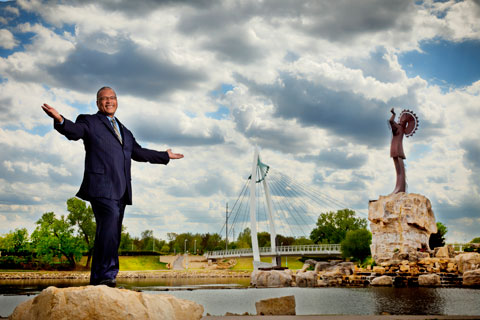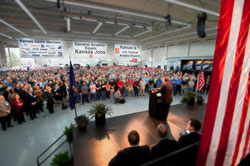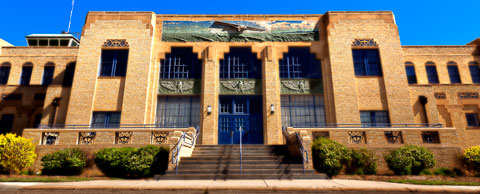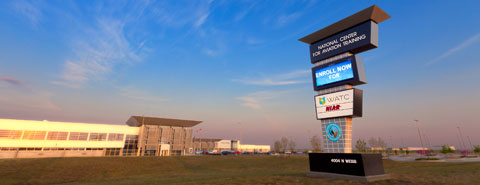There's no place like home
When you live in Wichita, you learn to weather the storms

It’s the morning of April 6, and Carl Brewer is feeling pretty good. He’s just won reelection to his second term as mayor of Wichita, the largest city in Kansas and self-proclaimed Air Capital of the World.
It is here in this flat, wind-swept, middle-of-the-prairie landscape that Clyde Cessna, Walter Beech, and Bill Lear started what became aviation empires, general aviation’s manufacturing mecca, and America’s supplier of aircraft during world wars, halcyon economic times, and, lately, the toughest recession since the Great Depression.
For Brewer, a native Wichitan, aerospace engineer, and career aviation employee—on a leave of absence from aviation parts supplier Spirit AeroSystems to serve as mayor of Wichita—the economic ups and downs of his city mean hard work, but nothing he can’t handle. When you live in Wichita, you get used to the changing economic landscape. And you always reach out to help your neighbor.
When you’re a Wichitan, you’re a member of a close-knit family, and you take care of that family.
The Air Capital
Stearman, Cessna, Mooney, and Beechcraft all were founded in Wichita in the late 1920s and early 1930s. Cessna and Hawker Beechcraft remain in Wichita today, along with Bombardier Learjet and Spirit AeroSystems, and both Airbus and Boeing maintain workforces in Wichita.
Oil was discovered in Wichita in 1914, and it became a major oil center—profits from oil meant local entrepreneurs could invest in the then-nascent aircraft industry. From 1917, when the Cessna Comet was introduced by the Swallow Airplane Co., until 1927, when Dwayne Wallace and Clyde Cessna started the Cessna Aircraft Co.—and from 1927, when Walter Beech started Travel Air and grew it to more than 600 employees—Wichita was a testbed for aviation. But then the stock market crash of 1929 and the ensuing Great Depression started what has now become a pattern in the aviation industry—“seven years up and three years down.”
With World War II, aviation manufacturing was back. There were 111,000 residents in Wichita in 1939; by 1943, there were 184,000. Beech Aircraft produced thousands of the Model 18 Twin Beech starting in 1937. The Cessna 172, introduced in 1956, set world sales records—more than 14,000 were built in 13 years. Then came Bill Lear and his Learjet; the first Learjet was produced in 1963. In 1977, nearly 17,000 aircraft were produced; by 1982, however, production was down to 4,200. In the 1980s, production again reflected the economic times: Beech laid off 2,500 people and Cessna 3,045 between mid-1981 and early 1982. Learjet laid off 1,000 people in 1984.
Kansas public officials and U.S. Secretary of Transportation Ray LaHood addressed more than 2,000 employees from Cessna, Bombardier Learjet, Hawker Beechcraft, and other Wichita general aviation companies in March.
The General Aviation Revitalization Act of 1994 halted the freefall and Cessna, which had stopped production of its venerable 172, resumed production of all piston-powered aircraft in 1996. The swing was heading back up.
The terrorist attacks of September 11, 2001, dealt a vicious blow to the aviation industry, just as it did to the rest of the nation. More than 15,000 aviation jobs disappeared in Wichita between 2001 and 2004. Focus turned to the development of small and mid-size jets in response to the demands of growing global companies. By 2007, between the economic impact of jet sales and a healthier economy, production set records with more than 4,000 aircraft produced.
In October 2008, aviation in Wichita employed 42,100 people. About one in 12 Wichitans worked in aviation. Since late 2008, however, Cessna, Hawker Beechcraft, and Bombardier Learjet have reduced employment in Wichita by 13,000. By July 2009, unemployment in Wichita had reached 10.3 percent. Today, 29,800 people work in aviation and aerospace in Wichita.
Surviving the ups and downs
The vagaries of the industry are reflected in its workforce. But what is unique to Wichita is that, for the most part, economic downturns foster resolve. People don’t leave Wichita when the going gets tough—or if they do, they ask when they can come back.
“We found that the primary breadwinner moved to a job in another area but left their families here if they could,” said Brewer of the tough times during 2009 and 2010. “I got calls from men and women who asked me, ‘Is it coming back? When can I come back?’”
What Wichita did during the worst of its latest downturn was to work with the United Way and the city’s Workforce Alliance center. It helped place laid-off workers in new careers, ventures, or pathways to education. The resource center saw hundreds of people in the darkest days of late 2009.
“It was packed,” Brewer recalls. “Everything they needed—help getting into schools, résumé development, GEDs, applying for unemployment—we helped. A lot of people took advantage of it.”
And companies such as Cessna set up retirement plans and layoffs designed in a way that reflected the family nature of the company—and of a workforce that is often multigenerational.
 Rebecca Fairall is a supervisor in material and requirements planning at Cessna Aircraft. Members of her family have worked for Cessna since the 1940s. Her great-grandmother, Halli Gerlach, started at Cessna in 1945—she left the family wheat farm each day to help supplement their income. Her sons were delivered by “Doc” Wallace, father of Dwane Wallace—who, along with his uncle, Clyde Cessna, started Cessna Aircraft. Two of Gerlach’s sons worked for Cessna, and they in turn had three children who went to work for Cessna, who in turn had children who now work or have worked for Cessna.
Rebecca Fairall is a supervisor in material and requirements planning at Cessna Aircraft. Members of her family have worked for Cessna since the 1940s. Her great-grandmother, Halli Gerlach, started at Cessna in 1945—she left the family wheat farm each day to help supplement their income. Her sons were delivered by “Doc” Wallace, father of Dwane Wallace—who, along with his uncle, Clyde Cessna, started Cessna Aircraft. Two of Gerlach’s sons worked for Cessna, and they in turn had three children who went to work for Cessna, who in turn had children who now work or have worked for Cessna.
The worst of the layoffs occurred at Cessna in 2009. Fairall’s mother, Jodi Swinehart, who had worked in purchasing for 32 years, elected to take the early retirement option. “The older generation essentially saved the jobs for the younger ones,” said Fairall. “My mom saved my job for me.”
“Cessna really tried to take care of people,” Swinehart said. “Last year was a very volatile year. There were special meetings, they helped set up people for unemployment, they gave 60 days’ notice. But we recognized that it was agonizing for them [Cessna] to let people go.”
Pollyannas?
Molly McMillin is the senior reporter for aviation and aerospace for The Wichita Eagle. She, too, is a native Wichitan. And she is an interesting study in remaking oneself in light of life changes. The mother of three children worked part-time jobs and fulfilled her dream of becoming a journalist, graduating from Wichita State University the same year her oldest son graduated from the local Bishop Carroll High School. She took over the newspaper’s aviation beat in 1999. Her father has flown GA for 50 years and owns a Piper Tri-Pacer based at nearby Augusta Airport (one of 10 airports surrounding Wichita; there are 140 airports in Kansas). McMillin recently got her pilot certificate so her father, who no longer has his medical, can continue to fly.
 “I don’t want to sound like a Pollyanna, but I believe we will always come back,” said McMillin. “I admit I’ve suffered a little ‘survivor guilt,’ especially when covering some of the stories and the people who were laid off. This is my home, my town.”
“I don’t want to sound like a Pollyanna, but I believe we will always come back,” said McMillin. “I admit I’ve suffered a little ‘survivor guilt,’ especially when covering some of the stories and the people who were laid off. This is my home, my town.”
McMillin has the unenviable task of reporting on the dark side of the aviation industry in Wichita. In early 2011 she was still writing stories with headlines such as “Aviation Job Fair Attracts Hundreds Willing to Move,” in which, she said, she faced men and women who were still out of work from the layoffs even with all of the support from the city and the industry.
“I really thought I’d be back to work in six or seven months,” she quoted interior aircraft mechanic David George in January. He was one of the hundreds attending the job fair. He had more than 14 years of aviation experience—and two years of experience looking for a job.
“We’re more than a little bruised,” McMillin said.
The elephant(s) in the room
Maybe Carl Brewer ran for mayor for job security—after all, he has been laid off by both Cessna and Boeing—but that’s not the impression one gets. “Every few years we go through this agonizing thing. It’s a cycle. People wonder, ‘Will it be me today?’” said Brewer. “This one has been the worst we’ve ever seen. And it’s been so painful to be here and be mayor—I’m from here. But the people here are tough. We’re tough in aviation and we’re important to the state of Kansas.”
That sentiment powered the first-ever rally for general aviation at Cessna headquarters in March, sponsored by the General Aviation Manufacturers Association. From U.S. Secretary of Transportation Ray LaHood through a series of state officials to Mayor Brewer—as well as all of the key industry leaders from the major manufacturing companies in Wichita—the rally brought together voices championing aviation in Wichita. More than 2,000 employees of Cessna, Bombardier Learjet, Hawker Beechcraft, and other manufacturers attended the rally.
“In my two years of traveling this country, I have never been more warmly welcomed than I have today,” said LaHood. “I will do everything in my power to persuade President Obama to come out here and see the Americans who make the American-made products like these magnificent airplanes. It doesn’t get any better than this.”

Jack Pelton, who recently retired as CEO of Cessna, said, “Secretary LaHood came here to see the workforce that is the envy of the world.”
The reference to “American-made”? Some companies are outsourcing to Mexico.
“Mexico is the elephant in the room,” said McMillin.
Similarly, in mid-2010, the state of Louisiana attempted to lure Hawker Beechcraft away from Wichita. “Everybody’s always trying to get the entire lock, stock, and barrel of any of our aviation companies,” Brewer said. “But they can’t produce as good of a product as we can.”
The Kansas legislature approved $40 million in incentives to keep Hawker Beechcraft in Wichita. This ensured 4,000 jobs will stay in Wichita through 2020.
“The biggest news of 2010 is that we said no to states that contacted our aviation companies—on a daily basis—that attempt to obtain our plants and our jobs,” said Brewer in his reelection acceptance speech.
In July, Bombardier agreed not to move out of Wichita because of state bonds that will support production of the composite Learjet 85. And several years ago, the legislature approved $500 million in bonds for Boeing Wichita’s commercial aircraft division—now Spirit AeroSystems—to help the facility win Boeing 787 work.
East Jesus
Prosperity shows itself in new housing, chain restaurants, shopping centers. Driving throughout the suburban areas of Wichita, that’s what you see. The housing is luxury, the restaurants are high-end, and the shopping centers line up next to golf courses. And nearly every new neighborhood sports a brand-new mega church, inspiring some locals to call Wichita’s east side “East Jesus.”

Aviation may account for more than 60 percent of the local economy, but Wichita has bragging rights in other areas that contribute to its wealth. Pizza Hut started here, as well as the Coleman Company, world famous for its camping supplies. Koch Industries, the second largest privately held company in the United States—which acquired Georgia-Pacific in 2005—is headquartered in Wichita.
Health care is Wichita’s second-largest industry, employing 28,000 people. Downtown, progress is slow but apparent. Old Town in the east end has been transformed from a warehouse district to a mixed-use neighborhood with residential space, nightclubs, restaurants, hotels, and museums.
Hometown boy made good
In March, aviation legend Clay Lacy spoke to the members of the Wichita Aero Club. For some, it was a surprise to learn that Lacy was a Wichitan. “I am a hometown boy made good,” said the famous movie stunt pilot and owner of one of the largest air charter operators in the world. “Wichita deserves its title as the Air Capital of the World because more airplanes have been built here than anywhere else.”
As a young boy, Lacy was fascinated with aircraft. He convinced his grandmother to let the man who would eventually teach him to fly—Orville Sanders—operate an airport on 40 acres of her farm. Orville Sanders Cannonball Airport was located on the corner of Maple and Tyler roads in west Wichita. It later became Westmeadows Airport, and eventually closed, but not before the young Lacy fell in love with flying.
“Wichita was a great place to grow up,” said Lacy. “Still is.”
Email the author at [email protected]. Photography by Mike Fizer.


